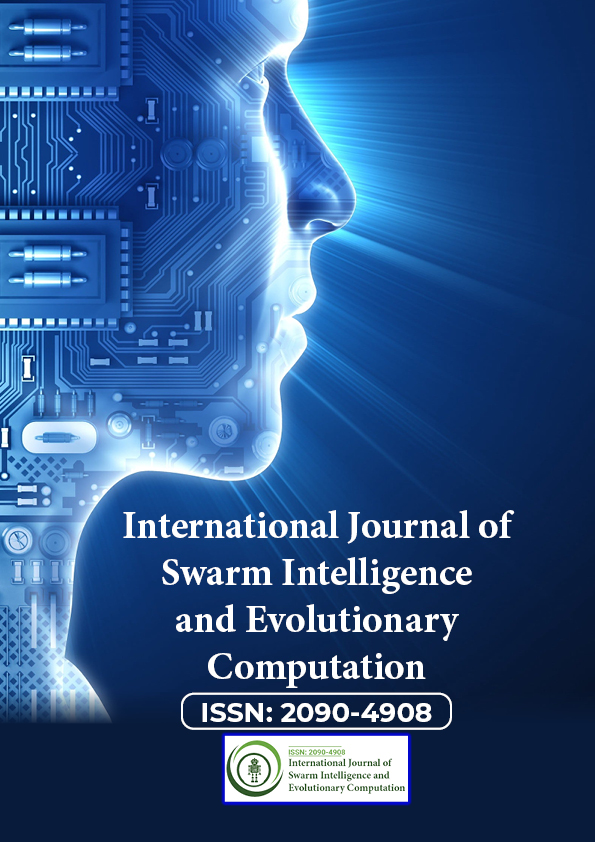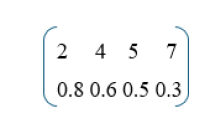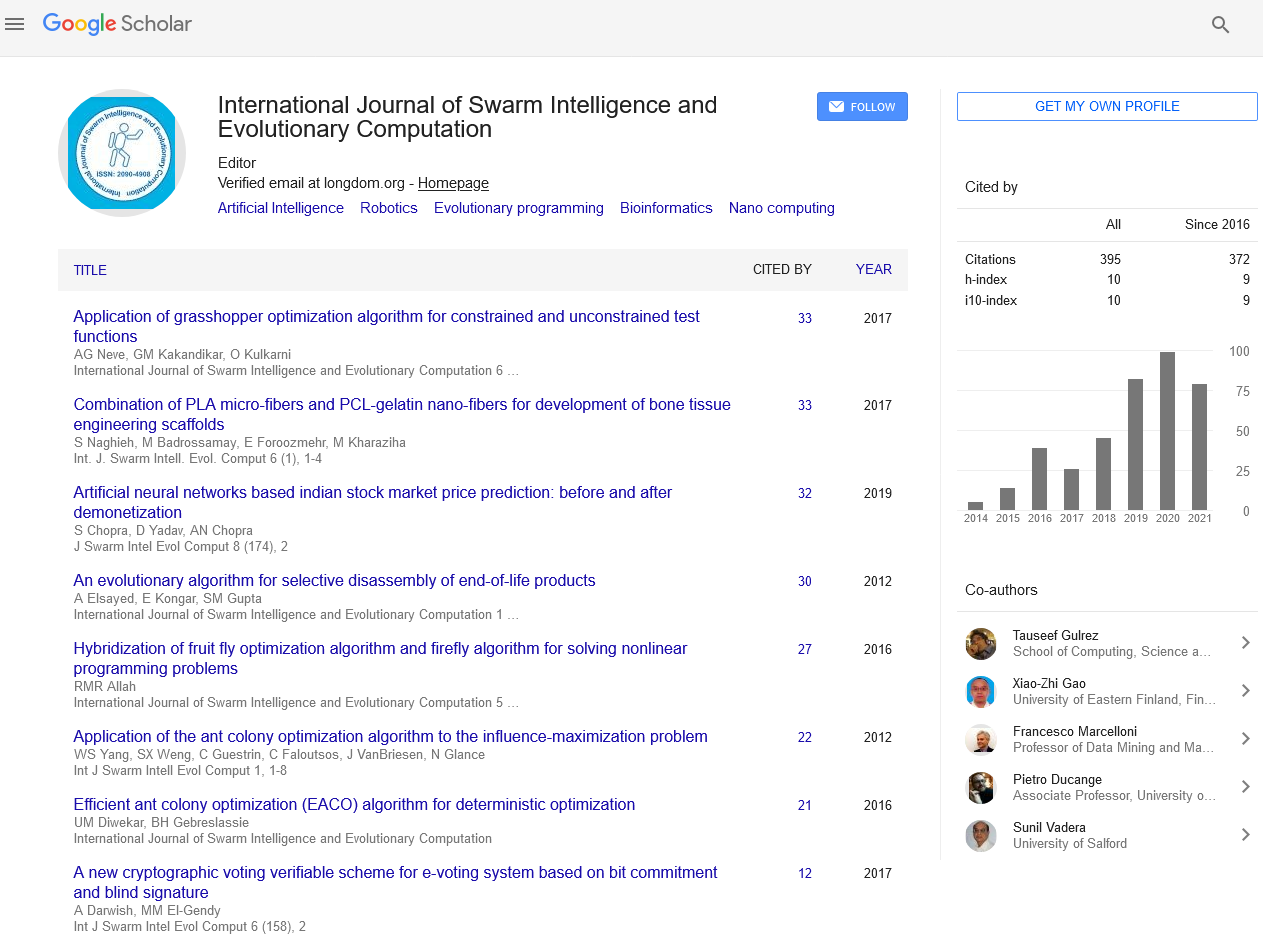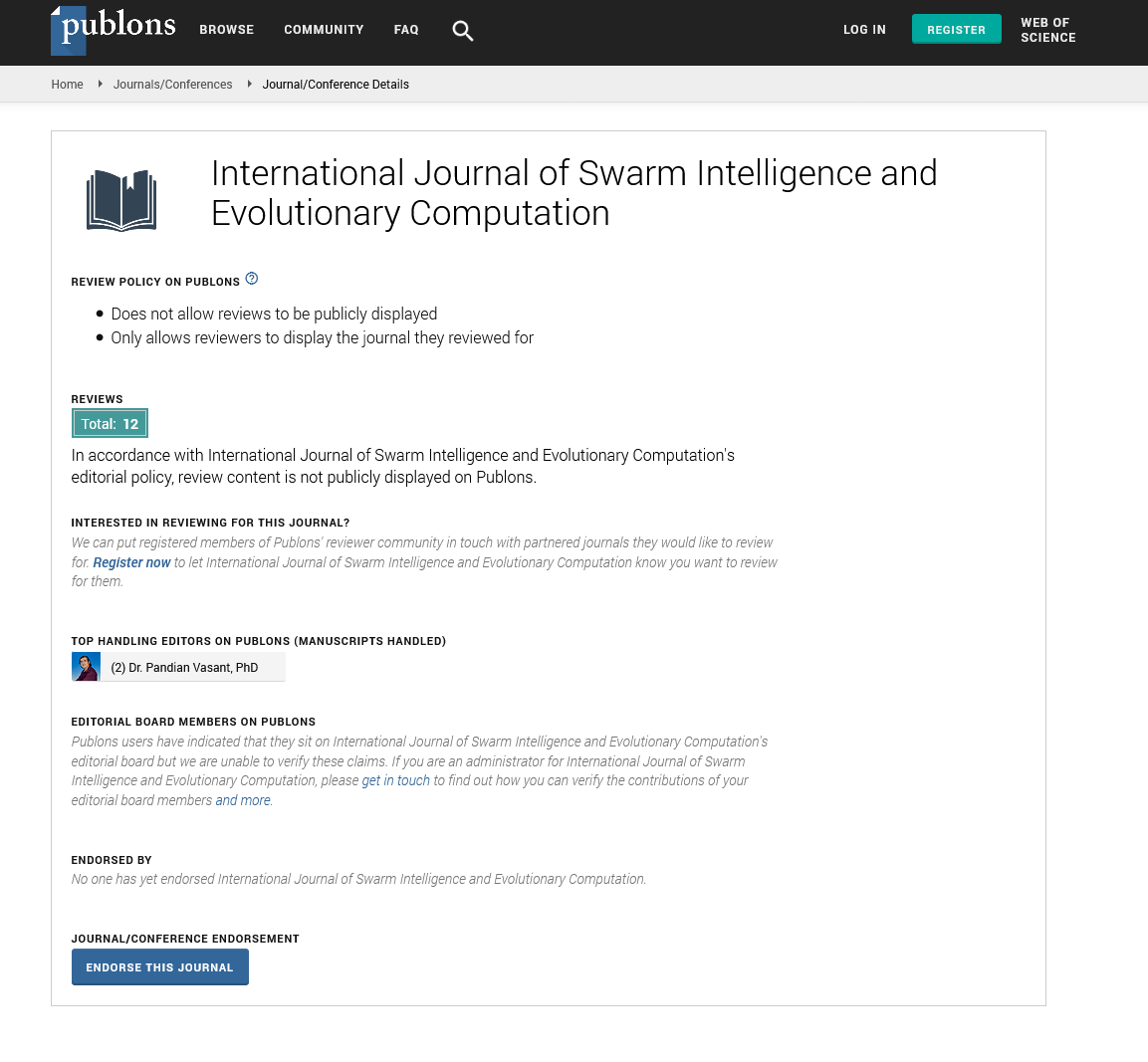Indexed In
- Genamics JournalSeek
- RefSeek
- Hamdard University
- EBSCO A-Z
- OCLC- WorldCat
- Publons
- Euro Pub
- Google Scholar
Useful Links
Share This Page
Journal Flyer

Open Access Journals
- Agri and Aquaculture
- Biochemistry
- Bioinformatics & Systems Biology
- Business & Management
- Chemistry
- Clinical Sciences
- Engineering
- Food & Nutrition
- General Science
- Genetics & Molecular Biology
- Immunology & Microbiology
- Medical Sciences
- Neuroscience & Psychology
- Nursing & Health Care
- Pharmaceutical Sciences
Research Article - (2024) Volume 13, Issue 4
A Revolution in Quantum Computing is Underway: The Essence-Units and Energy States are Fundamental Programming Units
Michael Naich1 and Alexander Rybalov2*2The Laboratory for AI, Machine Learning, Business & Data Analytics (LAMBDA), Tel-Aviv University, Tel Aviv, Israel
Received: 18-Jul-2024, Manuscript No. SIEC-24-26548; Editor assigned: 22-Jul-2024, Pre QC No. SIEC-24-26548 (PQ); Reviewed: 07-Aug-2024, QC No. SIEC-24-26548; Revised: 15-Aug-2024, Manuscript No. SIEC-24-26548 (R); Published: 23-Aug-2024, DOI: 10.35248/2090-4908.24.13.381
Abstract
This proposal advocates using energy states as fundamental units for quantum computer programming. Each programming unit is conceptualized as an energy state, manifested as an essence-unit. The essence-unit, defined as the minimal form encapsulating complete uniqueness or specificity, serves as the cornerstone of this paradigm. This approach allows recording various forms of matter on quantum computers in essence-units representing their energy states.
Recording energy states is achieved through the creation of four distinct coherent potentials facilitated by quantum dots or crystals. It is important to note that these energy states, embodied in essence-units, cannot be subdivided. The study examines the intricate relationship between similarity, fractals, and uniqueness in quantum dot operations, elucidating their profound implications for information transfer efficiency. Normalized entropy quantifies the charge localization in quantum dot impurities in systems exhibiting distortions. Utilizing N-level recording and entropyfractal dimension equivalence enables this paper to elucidate the potential of quantum dots in reducing transmission time and modeling complex systems. The proposed methodology represents a significant departure from the current state of quantum computing, offering unprecedented potential for overcoming previously intractable challenges.
Keywords
Quantum dot; Tsallis entropy; Renyi entropy; Quantum computer; Fractal dimension; Distortion; Information processing; N-dimensional programming unit; Electric field
Introduction
The unparalleled speed of quantum computing promises a transformative leap in computational capabilities [1,2]. Current qubit programming showcases both the potential and limitations of quantum computers [3,4]. Quantum computing's potential is evident in its ability to record qubit states despite challenges like spin superposition and scaling uncertainties [5]. Developing quantum computers with a limited number of qubits requires precision and scalability, highlighting the need for many qubits working cohesively [6]. The coherent manipulation of superconducting spin qubits and the potential for quantum supremacy with superconducting qubits further emphasize the promise of these technologies [7,8]. Additionally, scaling quantum computers involves challenges such as qubit connectivity and gate expressivity [9]. Despite these hurdles, qubit programming has proven effective for specific problems. The development of quantum computing faces key challenges, including material limitations, network design constraints, and the need for a paradigm shift in computing foundations [10-12]. Moreover, issues like quantum de-coherence and qubit interconnectivity must also be addressed [13].
This paper focuses on programming solutions that utilize quantum dots, exploiting their properties to enable n! (n factorial) possible operations [14-16]. The investigation examines the potential benefits of quantum dots, suggesting a promising avenue for advancing quantum computing beyond existing constraints [17]. Our approach employs an energy-based methodology that simplifies understanding the manifestation of quantum entities through their interactions. This article presents a novel approach through the energy states of quantum dots, representing a significant shift in programming paradigms [18].
In our forthcoming paper, we intend to apply the concept of essence and energy states. Essence units are the smallest indivisible units of quantum information. They encapsulate the complete uniqueness or specificity of a quantum entity and serve as fundamental building blocks in quantum computing. Energy states refer to the distinct states that an essence-unit can occupy. These states are defined by specific energy levels corresponding to the quantum properties of the essence-unit, including charge, spin, and other quantum characteristics.
The deliberate characteristics of quantum dots permit the generation of the energy state of the essence through the formation of four potentials in the form of an accumulating charge. We propose that the characteristics of each essence, shown as its minimum energy state, should be seen as a manifestation of the energy field's behavior. To explain how we determine the criteria for creating four potentials, we use Aristotle's four causes. These causes, proposed by the philosopher in ancient times, help classify and determine the essence.
Furthermore, we will examine the potential for irrational programming due to the properties of fractality and the use of entropy to characterize charge control on quantum dot impurities. Furthermore, additional possibilities for constructing recording algorithms and developing high accuracy and depth of material assimilation may be considered as well as the possibility of parallel transfer of the created pattern to solve similar problems. The recording of essence-units in their specific energy states allows for highly efficient and scalable quantum computing. This method simplifies the understanding of quantum entities' behavior and interactions enabling advanced quantum computations and data processing.
Operation on quantum dots
One possible approach is to utilize a quantum dot to record four distinct potential states. At present, the development of quantum computers is concentrated on composite quantum dots, which represent a promising avenue for future progress [19]. Quantum dots possess distinctive properties, including the capacity to generate single photons on demand and their potential utilization in quantum dot devices [20,21].
A compositional structure, in particular one that is capable of transferring, trapping, or releasing electrons through inertial or N-dimensional states, represents an intriguing solution [22,23]. We may then consider the creation of four potentials and their internal interactions as an analogue in the form of a volumetric holographic element, in which the information content remains constant as the block size increases. This results in the formation of a volumetric N-dimensional energy program unit, expressed in terms of energy states of program units [24-26]. For the purpose of recording the aforementioned energy units, we will once again utilize the properties of the dipole moment, tunnel effect and recombination effect to represent each quantum dot as a participant in an already binary system. One system is designed to receive information, while the other is designed to produce photo-luminescent radiation that generates data for the first quantum dot [27,28]. This system represents a potential solution to the effective implementation of our proposed approach. Accordingly, the properties of quantum dots will be employed to consider them as a medium for recording, while other quantum dots will be designated as emitters for recording. Quantum dots are essential in this process. They create and manipulate the energy states of essence units. By generating controlled electric fields and using quantum dot properties like dipole moments and recombination effects, we can accurately record and manipulate the energy states of essence units.
Materials and Methods
Recording method
In this method, we create four charged centers located on the second and third inner layers of quantum dots. These centers, which exhibit polarized, coherent, or unidirectional spin states, generate electric fields that represent the energy states of matter. The performance of essence units is revealed through their interaction with these electric fields.
The innovative method involves programming energy states which are formed as a result of the superposition of electromagnetic fields created by four distinct potentials. We propose naming the unit of such a record the Field of Active Recording of Nature (FARNA) which encapsulates the energetic state of matter. The FARNA technique enables precise recording and programming by identifying the minimal energy state that defines the essence-unit. In essence the FARNA technique captures and delineates the energy state by utilizing recording parameters that reflect four variables simultaneously. These variables interact to create a single unit of energy essence thereby providing a detailed and accurate representation of the energy state of the matter being studied.
To record a given unit, we need to determine the irradiation wavelength and the duration of the irradiation period. This helps us understand the depth and weight of potential formation. We use Aristotle’s four factors-charge depth profilingto quantify the wavelength and recording period. These four causes serve as a guide to identify the four wavelengths that represent the energy states of the essence units. The inversely proportional values of these wavelengths will determine the time of irradiation. The precision with which these values are determined facilitates the precise formation of energy states by profiling the charge of essential units.
Our proposed model is based on programming essence units as energy states, written through four or more potentials. These potentials, represented by four charge points, are closely linked to the unique characteristics of energy states whose dimension is at least three. The relationship between these potentials and exposure time determines the distinctiveness of the entity units. This is presented through the use of FARNA which represents a more sophisticated approach to the encoding of quantum computing data.
Methodology of FARNA determination
The FARNA determination methodology focuses on representing the minimal energy state of essence units. FARNA is a key concept that embodies the fundamental energy state of an essence unit, integral to our approach. Our methodology of programming based on essence-unit minimizes permitted combinations, streamlining the programming process and significantly enhancing execution speed. The resulting array, which has more restricted values than its initial counterparts, includes all possible combinations of subject values. This efficiency is vital for computational effectiveness.
Our methodology enables the recording of energy states for any essence unit. These energy states are defined through four bound potentials, each creating a specific electromagnetic field that represents the essence unit's energy state. To capture these electromagnetic fields, we use wavelengths ranging from 390 to 730 nanometers, including ranges like 390-410 nm, 415-435 nm, 440-480 nm, 495-515 nm, 515-545 nm, 550-575 nm, 580-605 nm, 610-635 nm, 640-680 nm, and 690-730 nm. These wavelengths align with the properties of essence units and optimize the recording process. The potentials associated with these wavelengths are graded on a scale from 1 to 10. Quantum dots play a significant role, as they contain electron traps where charge localization occurs, forming the potentials. To determine the charge value, we calculate the exposure time to the irradiation of an electron beam, scaling the resulting time values from 0.1 to 0.9 with FARNA values correlating to the time of exposure.
Recording a Cat's energy state using FARNA
Consider the example of recording a cat's energy state with FARNA. We can capture the unique essence of a cat by determining its minimal energy state through the interaction of four distinct electromagnetic fields. These fields, created by charged centers in quantum dots, represent the cat's energy state in three-dimensional space. This allows for efficient and precise recording and processing of quantum information.
The goal of this study is to record a cat's energetic state using the FARNA system. To do this, we need to accurately formulate four causes to determine the essence of the cat and its energetic expression. A child can recognize a cat in a book or on the street without knowing its breed or habits. This simplicity comes from the cat forming a unique characteristic of the entity-unit in the visible range when observed. Unlike traditional methods that break a cat into many small squares, our volumetric measurement and recording method treats each new cat as a separate identifiable object, saving significant resources.
In this discussion, we focus on recording the energy state of an ordinary cat, following Aristotle's principles, not Schrödinger's cat in a box. We use Aristotle's four causes-material, formal, efficient, and final-to relate these causes to four potential values, rated on a scale of 1 to 10, to determine the accuracy of the definition. The accuracy of the answer on a ten-point scale for the correspondence of the cause is determined by four wavelengths and their inversely proportional values, which correspond to the irradiation time.
The record of a cat's energetic state using the FARNA system is expressed as (2, 4, 5, 7), generating four waves that correspond to the potentials. Scaling for the relative unit of time results in the following correspondences: 2 corresponds to 0.8, 4 to 0.6, 5 to 0.5, and 7 to 0.3. Therefore, the energy state of cat in FARNA is:

Properties of similarity, fractals, and uniqueness in quantum dot operations
The interplay of three fundamental properties-similarity, fractals, and uniqueness-offers many possibilities for quantum dot operation and control. Structural similarities in quantum dots result in identical properties. Using N-level recording at a single point allows for the instantaneous transfer of these properties to all other similar points or designated ones. This capability significantly reduces the time for information transfer, surpassing traditional methods that involve transmitting entire arrays.
It was shown that greater impurity leads to increased disorder in the system [29]. To measure this disorder, Tsallis formalism was used. Entropy can be used to determine changes in electric fields under influence of impurities.
Quantum dot-enabled language learning: Harnessing structured dynamics for rapid proficiency acquisition
Integration of quantum dots into language learning: The integration of quantum dots into language learning processes can enhance language acquisition effectiveness. Structured dynamics applied to language learning at a single quantum dot allow for the seamless transfer of the acquired form to another point. This novel approach enables rapid assimilation of multiple languages, with each language being acquired in the shortest time possible. The effectiveness of this process depends on the clarity and correctness of the quantum dot's internal structure. The greater the precision and clarity of the energy levels which represent constraints from the minimum starting point to the maximum limit the more robust the knowledge [30-33].
The representation of language proficiency through sublevels within the energy structure illustrates the dynamics of language retention. A well-fixed language with numerous sub-levels between two extremes demonstrates stronger and more enduring comprehension. This can be explained by the fact that individuals tend to forget languages not used for an extended period, retaining only minimal understanding. Conversely, a language with a meticulously constructed structure, comprising numerous near-level sub-levels, enables seamless navigation through linguistic nuances. Such a highly organized system can engage in dialogue instantly, processing information without the burden of energy consumption or the need for prolonged reflection on individual words.
The stability of a highly organized and fixed quantum dot system is a key factor in language proficiency, allowing for swift comprehension and response to linguistic stimuli. This innovative approach, based on the properties of quantum dots, represents a paradigm shift in language learning and retention.
Possibility: The irrational formation of the information processing center-analogous to riding a bike
The acquisition of certain skills, like riding a bike, often defies theoretical explanations until one engages in practical experience. Unlike language knowledge, the ability to ride a bicycle persists even after extended periods of disuse. The seemingly irrational act of maintaining balance on two wheels becomes natural through movement. The stability of twowheeled vehicles is enhanced during motion, enabling effective maneuvering and control. A similar analogy can be drawn in our quantum dot system. The creation of energy structures on a quantum dot is subject to the reliability determined by the persistence of energy levels.
Like the decline in language knowledge without practice, maintaining a baseline level of knowledge in our system requires the continuous creation of new 'defects' in the structure, such as connections between quantum dots. These newly formed centers act as chemical hubs, facilitating communication between clusters. If these changes are not transient but become physically integrated aggregates or pits forming permanent defects, the alterations become ingrained in the system. Once established, these changes are permanent, preserving any information recorded at the minimal knowledge level as long as the system's chemical properties permit.
The system exhibits the potential for rapid and ultra-efficient learning and information processing, whether executed in a rational or irrational manner. Introducing an alteration similar to the persistent ability to ride a bicycle represents a lasting change in the system, one that is not easily removed. The stored information, maintained at a minimum level, persists as long as the system's chemical properties endure. At this point, our considerations are limited by the speed of light.
The paper introduces the concept of irrational formation in quantum computing drawing parallels to the ability to ride a bike. The continual creation of new defects in the system analogous to chemical hubs between quantum dots ensures the persistent storage of information at a minimum knowledge level. This not only enhances the learning process but also opens up avenues for ultra-fast information processing. The discussion of the topic is presented below.
Results and Discussion
Revolutionizing quantum computing through quantum dot-based programming
In advancing quantum computing, this paper explores a paradigm-shifting approach leveraging the unique properties of quantum dots. These confined semiconductor systems, operating at the nanoscale, offer an unparalleled platform for constructing innovative microchip structures. The potential applications of quantum dots, whether distributed evenly, chaotically, or within lattice sites of crystals, are vast and include the development of a new generation of computers. The internal structure of quantum dots, characterized by intricate levels of covalent and valence bonds, allows for a wide range of energy excitations. Viewing quantum dots as homogeneous hetero-structures comprising multiple quantum elements introduces a multi-functional aspect to their nature. This property provides the foundation for constructing qubits, with the potential number of qubits increasing exponentially with each additional shell.
This paper presents a revolutionary approach to quantum computing that leverages the distinctive properties of quantum dots. This proposed paradigm is expected to significantly alter the computing landscape, offering unparalleled speed, efficiency, and versatility. The model is based on programming, where essence-units represent energy states of any matter, recorded through four or more potentials. These potentials, represented by at least four charged points, play a pivotal role in determining the unique characteristics of energy states in a three or moredimensional space. The relationships between these potentials define the distinctiveness of essence-units through FARNA, offering a sophisticated approach to quantum computing data encoding. The proposed methodology for determining the minimal energy state, FARNA (Field of Active Recording of Nature), facilitates the recording of energy states of essence-units. This method uses four bound potentials representing the distinctive characteristics of energy states in a multi-dimensional space and employs wavelengths across the electromagnetic spectrum from deep ultraviolet to infrared to record these energy states. This detailed explanation connects the theoretical concepts of essence-units and energy states with practical methods of programming and recording in quantum computing, forming a comprehensive framework.
Conclusion
This investigation highlights the key role of similarity, fractals, and uniqueness in enhancing quantum dot operations. The study reveals new avenues for controlling disorder and optimizing information transfer in quantum systems by leveraging insights from entropy-fractal dimension relationships and the Tsallis formalism. These findings not only advance our understanding of quantum dot dynamics but also pave the way for innovative applications in various technological domains. The potential applications are numerous and diverse, including areas such as language processing and rapid learning, collectively representing a promising avenue for the future of quantum computing. Further experimentation and research are necessary to validate and refine the proposed concepts, paving the way for a quantum leap in computational capabilities.
References
- Preskill J. Quantum computing in the NISQ era and beyond. Quantum. 2018;2:79.
- Nielsen MA, Chuang IL. Quantum computation and quantum information. 2010.
- DiVincenzo DP. The physical implementation of quantum computation. Fortschr Phys. 2000;48(9-11):771-783.
- Shor PW. Polynomial-time algorithms for prime factorization and discrete logarithms on a quantum computer. SIAM review. 1999;41(2):303-332.
- Brassard G, Chuang I, Lloyd S, Monroe C. Quantum computing. Proc Natl Acad Sci. 1998;95(19):11032-11033.
[Crossref] [Google Scholar] [Pubmed]
- Bravyi S, Dial O, Gambetta JM, Gil D, Nazario Z. The future of quantum computing with superconducting qubits. J Appl Phys. 2022;132(16).
- Hays M, Fatemi V, Bouman D, Cerrillo J, Diamond S, Serniak K, et al. Coherent manipulation of an Andreev spin qubit. Science. 2021;373(6553):430-433.
[Crossref] [Google Scholar] [Pubmed]
- Neill C, Roushan P, Kechedzhi K, Boixo S, Isakov SV, Smelyanskiy V, et al. A blueprint for demonstrating quantum supremacy with superconducting qubits. Science. 2018;360(6385):195-199.
[Crossref] [Google Scholar] [Pubmed]
- Linke NM, Maslov D, Roetteler M, Debnath S, Figgatt C, Landsman KA, et al. Experimental comparison of two quantum computing architectures. Proc Natl Acad Sci U S A. 2017;114(13):3305-3310.
[Crossref] [Google Scholar] [Pubmed]
- De Leon NP, Itoh KM, Kim D, Mehta KK, Northup TE, Paik H, et al. Materials challenges and opportunities for quantum computing hardware. Science. 2021;372(6539):eabb2823.
[Crossref] [Google Scholar] [Pubmed]
- Cacciapuoti AS, Caleffi M, Tafuri F, Cataliotti FS, Gherardini S, Bianchi G, et al. Quantum internet: Networking challenges in distributed quantum computing. IEEE Network.2019;34(1):137-143.
- Gruska J. Quantum computing challenges. 2001:529-563.
- Gill SS, Kumar A, Singh H, Singh M, Kaur K, Usman M, et al. Quantum computing: A taxonomy, systematic review and future directions. Softw Pract Exp. 2022;52(1):66-114.
- Adamowski J, Kwaśniowski A, Szafran B. LO-phonon-induced screening of electro-electron interaction in D-centres and quantum dots. J Condens Matter Phys. 2005;17(28):4489.
- Troiani F, Hohenester U, Molinari E. Exploiting exciton-exciton interactions in semiconductor quantum dots for quantum-information processing. Phys Rev B. 2000;62(4):2263.
- Rybalov A, Naich M. Revolutionizing quantum computing: Essence-units and energy states as fundamental programming units.2024.
- Loss D, DiVincenzo DP. Quantum computation with quantum dots. Phys Rev A. 1998;57(1):120.
- Smith MJ, Lin CH, Yu S, Tsukruk VV. Composite structures with emissive quantum dots for light enhancement. Adv Opt Mater. 2019;7(4):1801072.
- Heindel T, Kim JH, Gregersen N, Rastelli A, Reitzenstein S. Quantum dots for photonic quantum information technology. Adv Opt Photonics. 2023;15(3):613-738.
- Arakawa Y. Prospects of quantum dots for advanced nanophotonic devices. 2007.
- Waissman J, Honig M, Pecker S, Benyamini A, Hamo A, Ilani S, et al. Realization of pristine and locally tunable one-dimensional electron systems in carbon nanotubes. Nat Nanotechnol. 2013;8(8):569-574.
[Crossref] [Google Scholar] [Pubmed]
- Petta JR, Johnson AC, Taylor JM, Laird EA, Yacoby A, Lukin MD, et al. Coherent manipulation of coupled electron spins in semiconductor quantum dots. Science.2005;309(5744):2180-2184.
[Crossref] [Google Scholar] [Pubmed]
- Vasilyev DV, Sokolov IV, Polzik ES. Quantum volume hologram. Phys Rev B Physical Review C. 2010;81(2):020302.
- Kim IH. Holographic quantum simulation. 2017.
- Maslov D, Dueck GW. Improved quantum cost for n-bit Toffoli gates. Electron Lett. 2003;39(25):1790-1710.
- Chen Y. Equivalent relation between normalized spatial entropy and fractal dimension. Phys A: Stat. Mech Appl. 2020;553:124627.
- Khordad R, Sedehi HR, Bahramiyan H. Simultaneous effects of impurity and electric field on entropy behavior in double cone-like quantum dot. Commun Theor Phys. 2018;69(1):95.
- Alivisatos AP. Semiconductor clusters, nanocrystals, and quantum dots. science. 1996;271(5251):933-937.
- Bertaina S, Gambarelli S, Tkachuk A, Kurkin IN, Malkin B, Stepanov A, et al. Rare-earth solid-state qubits. Nat Nanotechnol. 2007;2(1):39-42.
- Bimberg D, Grundmann M, Ledentsov NN. Quantum dot heterostructures. John Wiley & Sons; 1999.
- Chen Y. Equivalent relation between normalized spatial entropy and fractal dimension. Phys A: Stat. Mech Appl. 2020;553:124627.
- Efros AL, Rosen M. The electronic structure of semiconductor nanocrystals. Annu Rev Mater Sci. 2000;30(1):475-521.
- Hirayama R, Naruse M, Nakayama H, Tate N, Shiraki A, Kakue T, et al. Design, implementation and characterization of a quantum-dot-based volumetric display. Sci Rep.2015;5(1):8472.
[Crossref] [Google Scholar] [Pubmed]
Citation: Naich M, Rybalov A (2024) A Revolution in Quantum Computing is Underway: The Essence-Units and Energy States are Fundamental Programming Units. Int J Swarm Evol Comput. 13:381.
Copyright: © 2024 Naich M, et al. This is an open-access article distributed under the terms of the Creative Commons Attribution License, which permits unrestricted use, distribution, and reproduction in any medium, provided the original author and source are credited.


